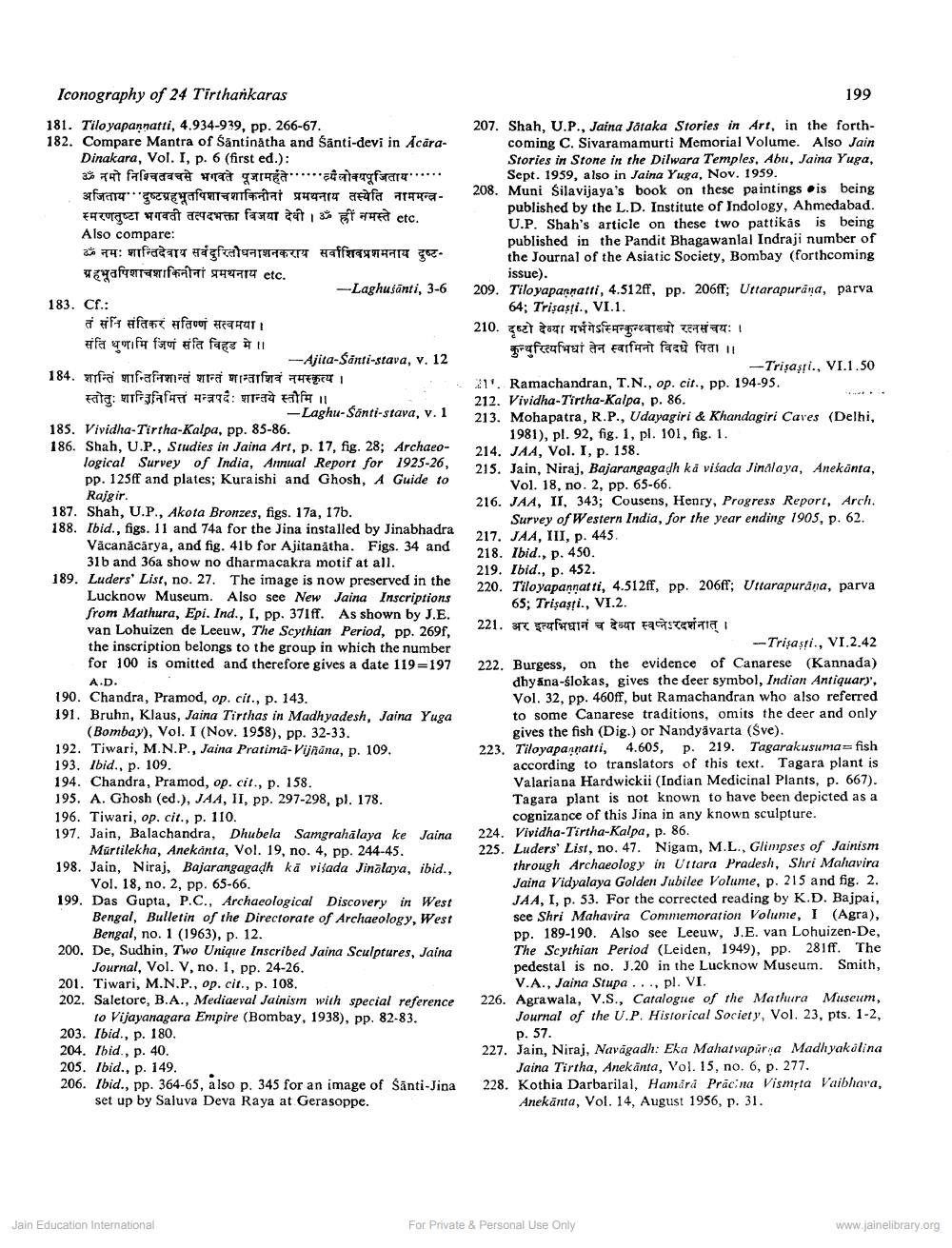________________
Iconography of 24 Tīrthankaras
181. Tiloyapanṇatti, 4.934-939, pp. 266-67.
182. Compare Mantra of Santinatha and Santi-devi in AcaraDinakara, Vol. I, p. 6 (first ed.): ॐ नमो निश्चितवचसे भगवते पूजामहंते
लोक्यपूजिताय ..... अजिताय दुष्टग्रहभूतपिशाचशाकिनीनां प्रमथनाय तस्येति नाममन्त्रस्मरणतुष्टा भगवती तत्पदभक्ता विजया देवी । ॐ ह्रीं नमस्ते etc. Also compare:
ॐ नमः शान्तिदेवाय सर्वदुरितोषनाशनकराय सर्वाशिवप्रशमनाय दुष्टग्रहभूत पिशाचशा किनीनां प्रमथनाय etc.
-Laghusanti, 3-6
183. Cf.:
तं संनि संतिकर सतिष्णं सत्वमया । संति धुणामि जिणं संति विहड मे ।। 184 शान्ति शान्तिनिशान्तं शान्तं शान्ताशिवं नमस्कृत्य । स्तोतुः शान्तिनिमित्तं मन्त्रपदैः शान्तये स्तौमि ॥
-Ajita-Santi-stava, v. 12
-Laghu-Sänti-stava, v. 1
185. Vividha-Tirtha-Kalpa, pp. 85-86. 186. Shah, U.P., Studies in Jaina Art, p. 17, fig. 28; Archaeological Survey of India, Annual Report for 1925-26, pp. 125ff and plates; Kuraishi and Ghosh, A Guide to Rajgir.
187. Shah, U.P., Akota Bronzes, figs. 17a, 17b.
188. Ibid., figs. 11 and 74a for the Jina installed by Jinabhadra Vacanācārya, and fig. 41b for Ajitanatha. Figs. 34 and 31b and 36a show no dharmacakra motif at all.
189. Luders' List, no. 27. The image is now preserved in the Lucknow Museum. Also see New Jaina Inscriptions from Mathura, Epi. Ind., I, pp. 371ff. As shown by J.E. van Lohuizen de Leeuw, The Scythian Period, pp. 269f, the inscription belongs to the group in which the number for 100 is omitted and therefore gives a date 119-197 A.D.
190. Chandra, Pramod, op. cit., p. 143.
191. Bruhn, Klaus, Jaina Tirthas in Madhyadesh, Jaina Yuga (Bombay), Vol. I (Nov. 1958), pp. 32-33.
192. Tiwari, M.N.P., Jaina Pratima-Vijñāna, p. 109.
193. Ibid., p. 109.
194. Chandra, Pramod, op. cit., p. 158.
195. A. Ghosh (ed.), JAA, II, pp. 297-298, pl. 178. 196. Tiwari, op. cit., p. 110.
197. Jain, Balachandra, Dhubela Samgrahalaya ke Jaina Mürtilekha, Anekanta, Vol. 19, no. 4, pp. 244-45. 198. Jain, Niraj, Bajarangagadh ka visada Jinalaya, ibid., Vol. 18, no. 2, pp. 65-66.
199. Das Gupta, P.C., Archaeological Discovery in West Bengal, Bulletin of the Directorate of Archaeology, West Bengal, no. 1 (1963), p. 12.
200. De, Sudhin, Two Unique Inscribed Jaina Sculptures, Jaina Journal, Vol. V, no. 1, pp. 24-26.
201. Tiwari, M.N.P., op. cit., p. 108.
202. Saletore, B.A., Mediaeval Jainism with special reference to Vijayanagara Empire (Bombay, 1938), pp. 82-83. 203. Ibid., p. 180.
204. Ibid., p. 40.
205. Ibid., p. 149.
206. Ibid., pp. 364-65, also p. 345 for an image of Santi-Jina
set up by Saluva Deva Raya at Gerasoppe.
Jain Education International
199
207. Shah, U.P., Jaina Jätaka Stories in Art, in the forthcoming C. Sivaramamurti Memorial Volume. Also Jain Stories in Stone in the Dilwara Temples, Abu, Jaina Yuga, Sept. 1959, also in Jaina Yuga, Nov. 1959.
208. Muni Silavijaya's book on these paintings is being published by the L.D. Institute of Indology, Ahmedabad. U.P. Shah's article on these two pattikäs is being published in the Pandit Bhagawanlal Indraji number of the Journal of the Asiatic Society, Bombay (forthcoming issue). 209. Tiloyapaṇnatti, 4.512ff, pp. 206ff; Uttarapuraṇa, parva 64; Trişaşti., VI.1.
210. दृष्टो देव्या गर्भगेऽस्मिन्कुन्थ्वाख्यो रत्नसंचयः । कुन्थुरित्यभिधां तेन स्वामिनो विदधे पिता ।।
-Trişaşti., VI.1.50
21. Ramachandran, T.N., op. cit., pp. 194-95. 212. Vividha-Tirtha-Kalpa, p. 86. 213. Mohapatra, R.P., Udayagiri & Khandagiri Caves (Delhi, 1981), pl. 92, fig. 1, pl. 101, fig. 1. 214. JAA, Vol. I, p. 158.
215. Jain, Niraj, Bajarangagadh ka visada Jinalaya, Anekānta, Vol. 18, no. 2, pp. 65-66.
216. JAA, II, 343; Cousens, Henry, Progress Report, Arch. Survey of Western India, for the year ending 1905, p. 62. 217. JAA, III, p. 445.
218. Ibid., p. 450.
219. Ibid., p. 452.
220. Tiloyapanṇatti, 4.512ff, pp. 206ff; Uttarapurāṇa, parva 65; Trişaşti., VI.2.
221. अर इत्यभिधानं च देव्या स्वप्नेऽरदर्शनात् ।
-Trisasti., VI.2.42 222. Burgess, on the evidence of Canarese (Kannada) dhyana-slokas, gives the deer symbol, Indian Antiquary, Vol. 32, pp. 460ff, but Ramachandran who also referred to some Canarese traditions, omits the deer and only gives the fish (Dig.) or Nandyävarta (Sve).
223. Tiloyapanṇatti, 4.605, p. 219. Tagarakusuma = fish according to translators of this text. Tagara plant is Valariana Hardwickii (Indian Medicinal Plants, p. 667). Tagara plant is not known to have been depicted as a cognizance of this Jina in any known sculpture. 224. Vividha-Tirtha-Kalpa, p. 86.
225. Luders' List, no. 47. Nigam, M.L., Glimpses of Jainism through Archaeology in Uttara Pradesh, Shri Mahavira Jaina Vidyalaya Golden Jubilee Volume, p. 215 and fig. 2. JAA, I, p. 53. For the corrected reading by K.D. Bajpai, see Shri Mahavira Commemoration Volume, I (Agra), pp. 189-190. Also see Leeuw, J.E. van Lohuizen-De, The Scythian Period (Leiden, 1949), pp. 281ff. The pedestal is no. J.20 in the Lucknow Museum. Smith, V.A., Jaina Stupa..., pl. VI.
226. Agrawala, V.S., Catalogue of the Mathura Museum, Journal of the U.P. Historical Society, Vol. 23, pts. 1-2, p. 57.
227. Jain, Niraj, Navagadh: Eka Mahatvapura Madhyakolina Jaina Tirtha, Anekanta, Vol. 15, no. 6, p. 277. 228. Kothia Darbarilal, Hamara Pracina Vismyta Vaibhava, Anekanta, Vol. 14, August 1956, p. 31.
For Private & Personal Use Only
www.jainelibrary.org




